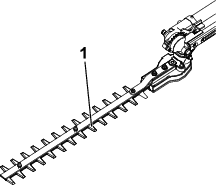Maintenance
After each use of the trimmer, complete the following:
-
Remove the battery pack from the trimmer before maintaining or cleaning.
-
Wipe the trimmer clean with a damp cloth any time there is an accumulation of debris. Do not hose the trimmer down or submerge it in water.
Warning
The hedge trimmer blades can cause cuts or amputation.
Be careful when handling the hedge trimmer with the protective cover removed.
-
Inspect the machine, check and tighten all fasteners. If any part is damaged or lost, repair or replace it.
Important: Use only the manufacturer’s recommended replacement parts and accessories.Have the product repaired only by an Authorized Service Dealer.
-
Brush debris away from air intake vents and exhaust on motor housing to prevent the motor from overheating.
Greasing the Hedge Trimmer
| Maintenance Service Interval | Maintenance Procedure |
|---|
Grease Type: Lithium–based grease.
-
Place the hedge trimmer on a flat surface and remove the battery pack; refer to Removing the Battery Pack from the Power Head.
-
Clean the grease fittings with a rag (Figure 11).
-
Connect a grease gun to each of the fittings and pump grease into the fittings until grease flows out from the fittings.
-
Wipe up any excess grease.

Lubricating the Blades
| Maintenance Service Interval | Maintenance Procedure |
|---|---|
| After each use |
|
Warning
The hedge trimmer blades can cause cuts or amputation.
Be careful when handling the hedge trimmer with the protective cover removed.
-
Shut off the trimmer, remove the battery pack, and place the trimmer on a flat surface.
-
Clean dirt and debris from the hedge trimmer, using a brush or a damp cloth with a mild detergent.
-
Apply light weight machine oil (such as #10) along the edge of the top blades (Figure 12).














